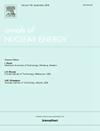Radiological impact assessment of a hypothetical accident at the Zaporizhzhia nuclear power plant
IF 1.9
3区 工程技术
Q1 NUCLEAR SCIENCE & TECHNOLOGY
引用次数: 0
Abstract
The atmospheric dispersion of radioactive materials and the resulting radiation dose were assessed for a hypothetical accident at the Zaporizhzhia Nuclear Power Plant in Ukraine. The release quantities of 131I and 137Cs were assumed to be the same as those released into the atmosphere in the Chernobyl nuclear accident. The evaluation utilized atmospheric dispersion and dose assessment models, both of which are key components of the Radiological Accident Preparedness System in Korea (RAPS-K) developed by the Korea Atomic Energy Research Institute. Simulation results showed that radioactive plumes initially moved to the western across Europe, and later, some plumes were transported to the Asia due to westerly winds. Dose assessments revealed that effective radiation doses were showed above 1 mSv in certain areas near the Zaporizhzhia plant, while radiation exposure remained below 0.1 mSv across the rest of Europe, Asia, and North America. Especially, the thyroid dose due to 131I was presented about 19 mSv and 29 mSv, respectively in Kyiv and Odesa of Ukraine.
核电厂假想事故的辐射影响评估
对乌克兰核电站假想事故中放射性物质的大气扩散和由此产生的辐射剂量进行了评估。131I和137Cs的释放量被认为与切尔诺贝利核事故中释放到大气中的量相同。评估使用了大气扩散和剂量评估模型,这两者都是韩国原子能研究所开发的韩国辐射事故准备系统(RAPS-K)的关键组成部分。模拟结果表明,放射性羽流最初向西移动,穿过欧洲,随后,一些羽流受西风的影响被输送到亚洲。剂量评估显示,在核电站附近的某些地区,有效辐射剂量超过1毫西弗,而欧洲、亚洲和北美其他地区的辐射暴露量仍低于0.1毫西弗。特别是,乌克兰基辅和敖德萨的131I甲状腺剂量分别为19毫西弗和29毫西弗。
本文章由计算机程序翻译,如有差异,请以英文原文为准。
求助全文
约1分钟内获得全文
求助全文
来源期刊

Annals of Nuclear Energy
工程技术-核科学技术
CiteScore
4.30
自引率
21.10%
发文量
632
审稿时长
7.3 months
期刊介绍:
Annals of Nuclear Energy provides an international medium for the communication of original research, ideas and developments in all areas of the field of nuclear energy science and technology. Its scope embraces nuclear fuel reserves, fuel cycles and cost, materials, processing, system and component technology (fission only), design and optimization, direct conversion of nuclear energy sources, environmental control, reactor physics, heat transfer and fluid dynamics, structural analysis, fuel management, future developments, nuclear fuel and safety, nuclear aerosol, neutron physics, computer technology (both software and hardware), risk assessment, radioactive waste disposal and reactor thermal hydraulics. Papers submitted to Annals need to demonstrate a clear link to nuclear power generation/nuclear engineering. Papers which deal with pure nuclear physics, pure health physics, imaging, or attenuation and shielding properties of concretes and various geological materials are not within the scope of the journal. Also, papers that deal with policy or economics are not within the scope of the journal.
 求助内容:
求助内容: 应助结果提醒方式:
应助结果提醒方式:


